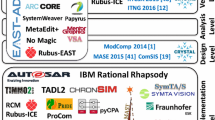Abstract
Timing models include crucial information that is required by the timing analysis engines to verify timing behavior of vehicular embedded systems. The extraction of this information from these systems is challenging due to the software complexity, distribution of functionality and multiple criticality levels. To meet this challenge, this paper presents a comprehensive end-to-end timing model for multi-criticality vehicular distributed embedded systems. The model is comprehensive, in the sense that it captures detailed timing information and supports various types of real-time network protocols used in the vehicular domain. Moreover, the paper provides a method to extract these models from the software architectures of these systems. The proposed model is aligned with the component models and standards in the vehicular domain that support the pipe-and-filter communication among their basic building elements.
Access this chapter
Tax calculation will be finalised at checkout
Purchases are for personal use only
Similar content being viewed by others
References
I. Crnkovic, M. Larsson, Building Reliable Component-Based Software Systems (Artech House, Norwood, MA, 2002)
S. Mubeen, J. Mäki-Turja, M. Sjödin, Support for end-to-end response-time and delay analysis in the industrial tool suite: issues, experiences and a case study. Comput. Sci. Inf. Syst. 10(1), 453–482 (2013)
N. Feiertag, K. Richter, J. Nordlander, J. Jonsson, A compositional framework for end-to-end path delay calculation of automotive systems under different path semantics, in CRTS Workshop (2008)
AUTOSAR Techincal Overview, Release 4.1, Rev.2, Ver.1.1.0. http://autosar.org
K. Hänninen et al., The rubus component model for resource constrained real-time systems, in IEEE Symposium on Industrial Embedded Systems (2008)
S. Sentilles, A. Vulgarakis, T. Bures, J. Carlson, I. Crnkovic, A component model for control-intensive distributed embedded systems, in CBSE (2008)
X. Ke, K. Sierszecki, C. Angelov, COMDES-II: a component-based framework for generative development of distributed real-time control systems, in 13th IEEE International Conference on Embedded and Real-Time Computing Systems and Applications, RTCSA 2007, pp. 199–208 (2007)
D. Schmidt, F. Kuhns, An overview of the real-time CORBA specification. Computer 33(6), 56–63 (2000)
A. Burns, R. Davis, Mixed criticality systems – a review, ninth edition, Technical report, Department of Computer Science, University of York, 2017. https://www-users.cs.york.ac.uk/burns/review.pdf.
S. Vestal, Preemptive scheduling of multi-criticality systems with varying degrees of execution time assurance, in 28th IEEE International Symposium on Real-Time Systems, pp. 239–243 (2007)
International Organization for Standardization (ISO), ISO 26262-1:2011: Road vehicles – Functional safety. http://www.-iso.-org/
Special C. of RTCA. DO-178C, software considerations in airborne systems and equipment certification (2011)
TIMMO-2-USE. https://itea3.-org/project/timmo-2-use.-html
Timing Augmented Description Language (TADL2) syntax, semantics, metamodel Ver. 2, Deliverable 11, August 2012
S. Mubeen, J. Mäki-Turja, M. Sjödin, Extraction of end-to-end timing model from component-based distributed real-time embedded systems, in Time Analysis and Model-Based Design, from Functional Models to Distributed Deployments (TiMoBD) Workshop Located at Embedded Systems Week (Springer, Berlin, 2011), pp. 1–6
S. Mubeen, J. Mäki-Turja, M. Sjödin, Communications-oriented development of component- based vehicular distributed real-time embedded systems. J. Syst. Archit. 60(2), 207–220 (2014)
K. Tindell, Adding time-offsets to schedulability analysis, Technical report, Department of Computer Science, University of York, England, 1994
J. Palencia, M.G. Harbour, Schedulability analysis for tasks with static and dynamic offsets, in IEEE International Real-Time Systems Symposium, p. 26 (1998)
J. Mäki-Turja, M. Nolin, Efficient implementation of tight response-times for tasks with offsets. Real-Time Syst. 40(1), 77–116 (2008)
T.P. Baker, Stack-based scheduling for realtime processes. Real-Time Syst. 3(1), 67–99 (1991) [Online]. Available: http://dx.doi.org/10.1007/BF00365393
L. Sha, R. Rajkumar, J. Lehoczky, Priority inheritance protocols: an approach to real-time synchronization. IEEE Trans. Comput. 39(9), 1175–1185 (1990)
ISO 11898-1, Road Vehicles? interchange of digital information? controller area network (CAN) for high-speed communication, ISO Standard-11898, November 1993
CANopen Application Layer and Communication Profile. CiA Draft Standard 301. Version 4.02. February 13, 2002. http://www.can-cia.org/index.php?id=440
Hägglunds Controller Area Network (HCAN), Network Implementation Specification, in BAE Systems Hägglunds, Sweden (Internal Document) (2009)
Requirements on Communication, Rel. 4.1, Rev. 3, Ver. 3.3.1, March, 2014. www.autosar.org/download/R4.1/AUTOSAR_SRS_COM.pdf. Accessed 05 May 2014
Audio/video bridging task group of IEEE 802.1, available at http://www.ieee802.org/1/pages/avbridges.html
R. Santos, M. Behnam, T. Nolte, P. Pedreiras, L. Almeida, Multi-level hierarchical scheduling in ethernet switches, in 2011 Proceedings of the Ninth ACM International Conference on Embedded Software (EMSOFT), pp. 185–194 (2011)
Time-Sensitive Networking Task Group, IEEE Std 802.1Qbv-2015 – IEEE Standard for Local and Metropolitan Area Networks – Bridges and Bridged Networks (2015)
S. Mubeen, J. Mäki-Turja, M. Sjödin, Integrating mixed transmission and practical limitations with the worst-case response-time analysis for controller area network. J. Syst. Softw. 99, 66–84 (2015)
Acknowledgements
The work in this paper is supported by the KKS foundation through the project PreVeiw. We thank our industrial partners Arcticus Systems, Volvo CE and BAE Systems Hägglunds.
Author information
Authors and Affiliations
Corresponding author
Editor information
Editors and Affiliations
Rights and permissions
Copyright information
© 2018 Springer International Publishing AG, part of Springer Nature
About this paper
Cite this paper
Mubeen, S., Gålnander, M., Lundbäck, J., Lundbäck, KL. (2018). Extracting Timing Models from Component-Based Multi-Criticality Vehicular Embedded Systems. In: Latifi, S. (eds) Information Technology - New Generations. Advances in Intelligent Systems and Computing, vol 738. Springer, Cham. https://doi.org/10.1007/978-3-319-77028-4_90
Download citation
DOI: https://doi.org/10.1007/978-3-319-77028-4_90
Published:
Publisher Name: Springer, Cham
Print ISBN: 978-3-319-77027-7
Online ISBN: 978-3-319-77028-4
eBook Packages: EngineeringEngineering (R0)




